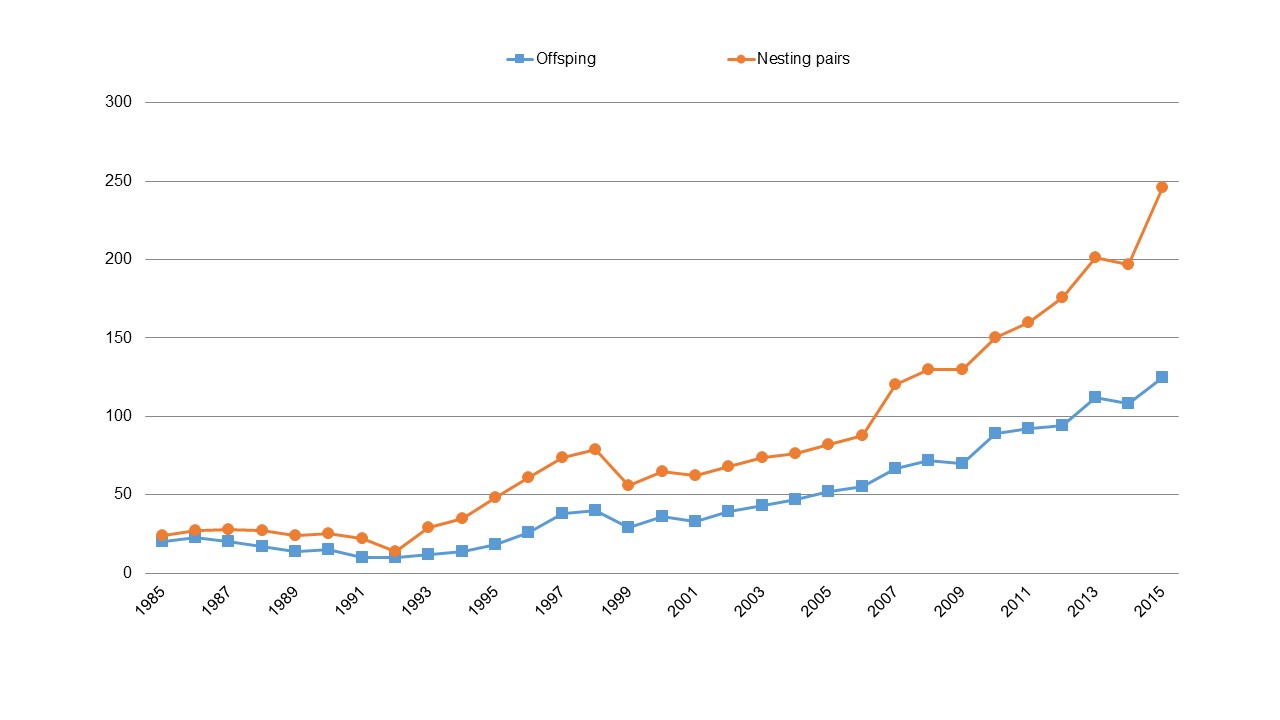Key message: Increase in the population of the Griffon vulture
Assessment: Griffon vulture was a common species in the Republic of Serbia until 1950s of the past century, which nested in the canyons and in the mountains around the Pannonian basin. The populations decreased in the entire Balkan Peninsula. In comparison to 1991 and 1992, the number of nesting couples and their young in the canyons of Uvac, Trešnjica and Mileševka rivers increased more than ten times. Permanent protection and improvement resulted in the population growth to 500 birds. Total of 246 nesting couples and 125 juvenile were recorded.
Griffon vulture (Gyps fulvus, Hablizl, 1883) is a species not capable of piercing the skin of dead herbivores with its beak. Its head and long beak are covered with white fluff. Griffon vulture weighs around 8.5 kg and its wingspan can reach 2.8 m. Griffon vulture nests on the rocks, forming colonies of different size. Griffon vulture was a common species in the Republic of Serbia until 50s of the past century, which nested in the canyons and in the mountains around the Pannonian basin. The populations decreased in the entire Balkan Peninsula. In comparison to 1991 and 1992, the number of nesting couples and their young in the canyons of Uvac, Trešnjica and Mileševka increased more than ten times. Permanent protection and improvement resulted in the population growth to 500 birds. There are 246 nesting couples and 125 young recorded (Figure above). The canyon of Uvac and Trešnjica are the most important sites for the return of the griffon vulture to the Balkans. There are two ongoing concurrent projects of reintroduction of the griffon vulture in Bosnia and Herzegovina and in two sites in Stara Planina one near Pirot (Republic of Serbia), and another on Kotel (Bulgaria).
Picture 1: Trend of population of Griffon vulture in Serbia

Indicator Name: Trend of Griffon vulture population restored
Institution/Author: Environmental Protection Agency/Slaviša Popović, Institute for biological researches “Sinisa Stankovic”/dr Saša Marinković
Use and interpretation:
The indicator shows trend of changes in the population abundance of Griffon vulture species from 1985. The change in the population of this bird shows the increase.
Key question(s) which indicator helps to answer
The indicator helps to answer the question: What is the trend in population growth of Griffon vulture in Serbia?
Use of indicator
The indicator is used to monitor population growth of Griffon vulture in Serbia. In comparison with 1991 and 1992, the number of nesting couples and their young in the canyons of Uvac, Trešnjica and Mileševka rivers increased more than ten times. Permanent protection and improvement resulted in the population growth to 500 birds. Total of 246 nesting couples and 125 juvenile were recorded.
Scale of appropriate use
Number of nesting couples and juveniles.
Potential for aggregation:
Meaning of upward or downward trends (“good or bad”)
Griffon vulture was a common species in the Republic of Serbia until 1950s of the last century, which nested in the canyons and in the mountains around the Pannonian basin. The populations decreased in the entire Balkan Peninsula.
Possible reasons for upward or downward trends:
Permanent protection and improvement resulted in the population growth to 500 birds in Serbia. A total of 246 nesting couples and 125 young have been recorded. The canyons of Uvac and Trešnjica Rivers were the most important sites for the return of the griffon vulture to the Balkans. Today two concurrent projects of reintroduction of the griffon vulture in Bosnia and Herzegovina and in two sites in Stara Planina being are implemented: one near Pirot (Republic of Serbia), and another on Kotel (Bulgaria).
Implications for biodiversity management of change in the indicator:
The indicator is traditionally described in annual state of the environment reports in Serbia, and it is determined as biodiversity indicator, according to the Rulebook on the National list of environmental protection indicators (Official Gazette of the Republic of Serbia No. 37/2011).
Units in which it is expressed:
The number of individuals per unit area. Number of breeding pairs. Surface expressed in hectares (ha).
Description of source data:
Institute for nature protection of the Republic of Serbia
Bird Protection and Study Society of Serbia
Calculation procedure:
The trend in changes of population abundance of selected species of birds according to the expert and administrative lists and methodology of counting and assessment developed by the European Agency for Environmental Protection. Dynamic of habitat changing of habitats according to EUNIS classification and / or the CORINE Land Cover methodology.
Most effective forms of presentation:
(graph types, maps, narratives, etc.-give examples where possible):
The best ways to present this indicator are tables and graphs and they provide opportunity to monitor progress regarding this indicator and to record trends observed.
Limits to usefulness and accuracy:
Access to data, slow data exchange and update
Updating the indicator:
Annually.
Closely related indicators
Species diversity – birds population trend
Trend in the number of carnivorous mammal population
Additional information and comments
Serbia